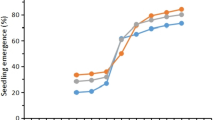Summary
Carrots for fodder purposes
II. The cultivation, the quality and a few correlations important in breeding
The area devoted to carrots as major crop is not large in the Netherlands (800 to 1000 ha); it is more frequently undersown and used as a catchcrop (3000 ha). In the latter case rye is the traditional companion crop, but sometimes peas, flax and spring barley are also used.
Carrots are mainly utilized as a feed crop. Some red-fleshed varieties are appreciated for human consumption under the name of winter carrots. The quality of these carrots is improved when they are grown with a companion crop.
Research on the different varieties has shown, that there exists a marked correlation between the various characters. The dry-matter content is highest in the conical, tapering forms that grow deep in the soil. The latter are difficult to lift, but they are winter hardy and of good keeping quality (Wessemer land race, Robra). The cylindrical types (Witte Uitkijker, Mollestaart) have a lower dry-matter content. The more conical variants, with only a small green crown, always differ from the more cylindrical forms by having a higher dry-matter content.
The carotene percentage of the root is closely correlated with its color. Table 1 gives the carotene content in mg per kg dry matter. It was discovered that within a given type the carotene content was highest in the most intensively colored variants.
The dry-matter content has been studied in connection with the refractive index of the expressed sap. One instance is illustrated by fig. 1. An exact determination of the dry-matter percentage is, however, not possible by means of the refractometer.
On an average the crude-protein content of the dry matter of carrots is 6 to 10%. There does not seem to exist important varietal differences.
No relation has been found between the dry-matter content and the protein content. Fig. 2 represents an analysis made in this connection of a trial field with carrots as principal crop and fig. 3 shows the results of a corresponding study with carrots as undersown crop.
Similar content being viewed by others
Literatuur
Wijbrans, J. R., Voederwortelen. I. De indeling en de beschrijving van het in Nederland geteelde sortiment. Euphytica 2 (1953): 149–156.
Author information
Authors and Affiliations
Rights and permissions
About this article
Cite this article
Scheijgrond, W. Voederwortelen. Euphytica 2, 157–160 (1953). https://doi.org/10.1007/BF00038917
Received:
Published:
Issue Date:
DOI: https://doi.org/10.1007/BF00038917




